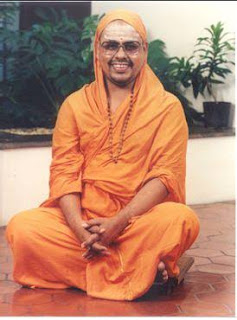ॐ गं गणपतये नमः।
How subtle is the knowledge of oneself! It is all about recognizing the nature of reality.
Having accepted that you are consciousness distinct from the body-mind-sense complex, you could still imagine you are a tiny drop in the ocean of consciousness, if your identification is with the body...it is like the space within a room identifying with the room and saying I am the size of the room. When we think like this, it means in our understanding, there are two things of the same reality ie space and the room. So the room confines the space and the space is only room-space.
So too you might imagine that you are consciousness alright, yet you are only a drop of the ocean of consciousness called Ishvara, confined by, limited by the body-mind complex.
Advaita however points out that, you are the all-pervading Consciousness, totally limitless.How can this be so?
By proper atma-anatma viveka, you recognize that you are self-revealing, self-evident consciousness distinct from the body-mind complex. The consciousness that you are is not a part, property, product of the body-mind complex. It is independent of the body-mind complex, it pervades and empowers the body-mind complex. It survives the fall of the body-mind complex. It is not available for transaction without the body-mind complex.
At this point, if you think there are two entities of the same order of reality, Atma and anatma, consciousness and body-mind complex, then naturally you would think that you are a drop in the ocean of consciousness, quite distinct from other drops!
So at this point we need to question if consciousness and the body-mind complex are the same order of reality?
The body-mind complex is made up of different part, intelligently put together to be able to perform it's functions. Skin, bone, blood, fat, muscles, nerves, ligaments, tendons, vital organs, hormones etc are different constituents of the body. Not only is each constituent dependent on something else, the body as a whole is dependent on it's individual constituents, as well as on factors external to it. The body is also changing. And above all it is dependent on consciousness to even be recognized. So all-in-all the body is a dependent changing entity.
So the first point to note about the body is that it is a dependent changing entity. The body is limited by time, space and object.
What about consciousness? Sruti is pramanam for the nature of consciousness. Consciousness is not an object of knowledge - it is the very subject, the self. So consciousness cannot be objectified like the body. It is totally independent - it does not depend on anything else. It is not limited by time, space or object. Consciousness never changes, nor is it divisible. It is a partless whole.
In fact we can say, the body-mind is in consciousness. Is it like a log of wood, in the ocean ...meaning is the body-mind complex different from consciousness?
Here is where we find that the body-mind complex is nothing but a form of the principle of existence (सत्). We should understand this very well.
Body is.
Skin is.
Bone is
Ligament is
and so on....meaning body exists, each constituent of the body exists.
Now if we take any one constituent, say skin ... skin is
Skin is made of several types of cells.
Each type of cell is.
The cells are made of their individual components. Each component is.
In this way we keep looking for what is common to each of the components...we find the irreducible common denominator is the principle of existence or isness of everything. The isness does not vary ...just its form varies. Isness in the form of each constituent of a cell, isness in form of a cell, isness in form of each constituent of the skin, ....isness in form of bone, ligament, tendon, muscle, vital organs, hormones etc , isness in form of the body.
Isness does not change. The form of isness appears to change.
So now do we have two entities - Isness (सत्) and Consciousness ( चित्)?
When you say 'I am', undeniably you are a conscious entity - so you can say Consciousness is ... because 'am' is first person singular of 'is'. This consciousness that you are, is, the isness. They are not different. चित् is सत्. सत् is चित्.
So now is the body-mind seperate from you consciousness? It is not ...it is merely a form of consciousness having a name called body?
There is just one limitless Consciousness appearing as the knower of the body, the body, as well as the knowing.The perceiver, the perceived, the perception are all just like waves in the ocean of consciousness. From the standpoint of the wave (a limited standpoint) it would appear like consciousness is confined by the wave. From the standpoint of consciousness, there is only one limitless consciousness ...there is no wave standing as a seperate entity to limit it.
So are you a drop of consciousness in the vast ocean of consciousness, or are you the limitless consciousness?
Om Tat Sat








